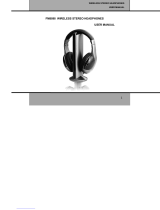
Important safety information
2 | RS 175
Important safety information
왘 Read this instruction manual carefully and completely before using the
product.
왘 Always include this instruction manual when passing the product on to
thi
rd parties.
왘 Do not use an obviously defective
product.
Preventing damage to he
alth and accidents
왘 Protect your hearing from high volume levels. Permanent hearing dam-
age may occur when headphones
are used at high volume levels for
long periods of time. Sennheiser headphones sound exceptionally good
at low and medium volume levels.
왘 Keep the headphones at least 10 cm/3.94” from cardiac pacemakers or
i
mplanted defibrillators. The headphones contain magnets that gener-
ate a magnetic field which could cause interference with cardiac pace-
makers and implanted defibrillators.
왘 Keep the product, accessories and pac
kaging parts out of reach of chil-
dren and pets to prevent accidents and choking hazards.
왘 Do not use the product in situations which require special attention
(e.g
. in traffic or when performing skilled jobs).
Preventing damage to the product and malfunctions
왘 Always keep the product dry and do not
expose it to extreme tempera-
tures to avoid corrosion or deformation. The normal operating tem-
perature is from 0 to 40°C/32 to 104°F.
왘 Use only attachments/accessories/spare parts sup
plied or recom-
mended by Sennheiser.
왘 Unplug the power supply unit from the A
C wall outlet if you are not
going to use the product for extended periods of time.
왘 Varnish or furniture polish may degrade the feet
of the transmitter,
which could stain your furniture. You should therefore place the trans-
mitter on a non-slip pad to avoid potential staining of furniture.
왘 Do not place your headphones on a g
lass dummy head, chair armrest or
similar objects for long periods as this can widen the headband and
reduce the contact pressure of the headphones.
왘 Clean the product only with a soft, dry cloth.
Intended use/Liability
This wireless headphone system is suita
ble for use with hi-fi systems, TV
sets, and home cinema systems and supports both analog and digital sig-
nals simultaneously.
This product is intended for private domestic use only. It is not suitable for
commercial use. This product is also not intended to be used with portable
audio devices.
It is considered improper use when this product is used for any application
not named in this instruction manual and the associated product guides.
Sennheiser does not accept liability for damage arising from abuse or mis-
use of this product and its attachments/accessories.






















